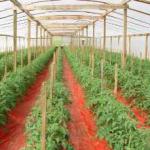Tomato, Greenhouse
A mid- to late-spring and early summer crop seeded in January-February can be profitable for growers, especially those with a retail outlet for their crop. A fall crop, seeded in late June for harvest through October into early December. Keep in mind that a fall crop is less productive because of shorter days and, in spite of lower heating costs, the profitability of the crop remains questionable. However, some growers continue to manage a spring/summer crop into the fall if there is a strong market demand.
Major disease problems in this crop:
- Phytophthora Blight
- Pythium Fruit Rot
- Solanaceous, Alternaria Fruit Rot
- Solanaceous, Anthracnose
- Solanaceous, Bacterial Canker
- Solanaceous, Bacterial Spot
- Solanaceous, Blossom End Rot
- Solanaceous, Cucumber Mosaic Virus
- Solanaceous, Early Blight
- Solanaceous, Late Blight
- Solanaceous, Powdery Mildew
- Solanaceous, Septoria Leaf Spot
- Solanaceous, Tobacco Mosaic Virus
- Solanaceous, Tomato Spotted Wilt Virus
- Solanaceous, Verticillium Wilt
- Tomato, Bacterial Speck
- Tomato, Blotchy Ripening
- Tomato, Buckeye Rot
- Tomato, Cat Facing
- Tomato, Fruit Cracking
- Tomato, Fulvia Leaf Mold
- Tomato, Pith Necrosis
- Tomato, Stitching
- White Mold
Major insect pests that affect this crop:
The Center for Agriculture, Food and the Environment and UMass Extension are equal opportunity providers and employers, United States Department of Agriculture cooperating. Contact your local Extension office for information on disability accommodations. Contact the State Center Director’s Office if you have concerns related to discrimination, 413-545-4800 or see ag.umass.edu/civil-rights-information.
